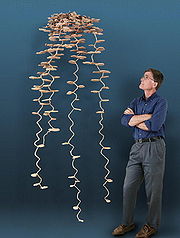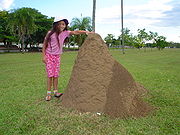
Ant colony
Encyclopedia


Lair
Lair may refer to:*An animal's lair or home; see :Category:Shelters built or used by animals*Lair , a 2007 video game*In Scots language, lair refers to a burial-plot in a graveyard...
where ant
Ant
Ants are social insects of the family Formicidae and, along with the related wasps and bees, belong to the order Hymenoptera. Ants evolved from wasp-like ancestors in the mid-Cretaceous period between 110 and 130 million years ago and diversified after the rise of flowering plants. More than...
s live, eat and mate. Colonies consist of a series of underground chambers, connected to each other and the surface of the earth by small tunnels. There are rooms for nurseries, food storage, and mating. The colony is built and maintained by legions of worker ants, who carry tiny bits of dirt in their mandibles
Mandible (insect)
Insect mandibles are a pair of appendages near the insect’s mouth, and the most anterior of the three pairs of oral appendages . Their function is typically to grasp, crush, or cut the insect’s food, or to defend against predators or rivals...
and deposit them near the exit of the colony, forming an ant-hill. Food carried in by workers is retrieved from the surrounding environment and can be traced from colony to colony by the use of isotopes.
Ant colonies are eusocial, and are very much like those found in other social Hymenoptera
Hymenoptera
Hymenoptera is one of the largest orders of insects, comprising the sawflies, wasps, bees and ants. There are over 130,000 recognized species, with many more remaining to be described. The name refers to the heavy wings of the insects, and is derived from the Ancient Greek ὑμήν : membrane and...
, though the various groups of these developed sociality independently through convergent evolution
Convergent evolution
Convergent evolution describes the acquisition of the same biological trait in unrelated lineages.The wing is a classic example of convergent evolution in action. Although their last common ancestor did not have wings, both birds and bats do, and are capable of powered flight. The wings are...
. Eggs
Egg (biology)
An egg is an organic vessel in which an embryo first begins to develop. In most birds, reptiles, insects, molluscs, fish, and monotremes, an egg is the zygote, resulting from fertilization of the ovum, which is expelled from the body and permitted to develop outside the body until the developing...
are laid by one or sometimes more queens. Queens are different in structure; they are the largest ants of the colony as a consequence of their egg-laying. Most of the eggs that are laid by the queens grow up to become wingless, sterile females called "workers". Periodically, swarms of new winged queens and males (the alate
Alate
An alate is a winged reproductive of a social insect . Alate females are typically those destined to become queens , whereas alate males are occasionally referred to as "drones"...
s) are produced in most species, which leave to mate. The males die shortly thereafter, while the surviving queens either found new colonies or occasionally return to their old one. The surviving queens can live up to around 21 years. People raise ant colonies in captivity for research and as a hobby. An "ant terrarium" used for this purpose is called a formicarium
Formicarium
A formicarium or ant farm is a vivarium which is designed primarily for the study of ant colonies and how ants behave. Those who study ant behavior are known as myrmecologists.-History:...
. They are often made thin enough that one can see the entire colony inside their nest. These are also called ant farms.
Unicoloniality and supercolonies
Most commonly, ants from different nests exhibit aggression toward each other. However, some ants exhibit the phenomenon called unicoloniality, where worker ants freely mix between different nests. A group of nests where ants do not exhibit mutual aggression is known as a supercolony — this form of organization is known as supercoloniality, and ants from different supercolonies of the same species do exhibit mutual aggression. Populations in supercolonies do not necessarily span a contiguous area.Until 2000, the largest known ant supercolony was on the Ishikari
Ishikari Subprefecture
is a subprefecture of Hokkaidō prefecture, Japan, located in the western part of the island. Its population in 2003 was 2,279,943.There are 6 cities, three towns, and one village under its jurisdiction. The subprefectural capital is Sapporo, also the capital of Hokkaidō prefecture...
coast of Hokkaidō
Hokkaido
, formerly known as Ezo, Yezo, Yeso, or Yesso, is Japan's second largest island; it is also the largest and northernmost of Japan's 47 prefectural-level subdivisions. The Tsugaru Strait separates Hokkaido from Honshu, although the two islands are connected by the underwater railway Seikan Tunnel...
, Japan
Japan
Japan is an island nation in East Asia. Located in the Pacific Ocean, it lies to the east of the Sea of Japan, China, North Korea, South Korea and Russia, stretching from the Sea of Okhotsk in the north to the East China Sea and Taiwan in the south...
. The colony was estimated to contain 306 million worker ants and one million queen ants living in 45,000 nests interconnected by underground passages over an area of 2.7 km² (667.2 acre). In 2000, an enormous supercolony of Argentine ant
Argentine ant
The Argentine ant, Linepithema humile, is a dark ant native to northern Argentina, Uruguay, Paraguay, and southern Brazil...
s was found in Southern Europe
Southern Europe
The term Southern Europe, at its most general definition, is used to mean "all countries in the south of Europe". However, the concept, at different times, has had different meanings, providing additional political, linguistic and cultural context to the definition in addition to the typical...
(report published in 2002). Of 33 ant populations nested along the 6004 kilometres (3,730.7 mi) stretch along the Mediterranean and Atlantic coasts in Southern Europe, 30 belonged to one supercolony with estimated millions of nests and billions of workers, interspersed with three populations of another supercolony. The researchers claim that this case of unicoloniality cannot be explained by loss of their genetic diversity due to the genetic bottleneck of the imported ants. In 2009, it was demonstrated that the largest Japanese, Californian and European Argentine ant
Argentine ant
The Argentine ant, Linepithema humile, is a dark ant native to northern Argentina, Uruguay, Paraguay, and southern Brazil...
supercolonies were in fact part of a single global "megacolony".
Another supercolony, measuring approximately 100 km (62.1 mi) wide, was found beneath Melbourne, Australia
Australia
Australia , officially the Commonwealth of Australia, is a country in the Southern Hemisphere comprising the mainland of the Australian continent, the island of Tasmania, and numerous smaller islands in the Indian and Pacific Oceans. It is the world's sixth-largest country by total area...
in 2004.
Ant-hills

Earth
Earth is the third planet from the Sun, and the densest and fifth-largest of the eight planets in the Solar System. It is also the largest of the Solar System's four terrestrial planets...
, sand
Sand
Sand is a naturally occurring granular material composed of finely divided rock and mineral particles.The composition of sand is highly variable, depending on the local rock sources and conditions, but the most common constituent of sand in inland continental settings and non-tropical coastal...
, pine
Pine
Pines are trees in the genus Pinus ,in the family Pinaceae. They make up the monotypic subfamily Pinoideae. There are about 115 species of pine, although different authorities accept between 105 and 125 species.-Etymology:...
needles, or clay
Clay
Clay is a general term including many combinations of one or more clay minerals with traces of metal oxides and organic matter. Geologic clay deposits are mostly composed of phyllosilicate minerals containing variable amounts of water trapped in the mineral structure.- Formation :Clay minerals...
or a composite of these and other materials that build up at the entrances of the subterranean dwellings of ant colonies as they are excavated. A colony is built and maintained by legions of worker ant
Ant
Ants are social insects of the family Formicidae and, along with the related wasps and bees, belong to the order Hymenoptera. Ants evolved from wasp-like ancestors in the mid-Cretaceous period between 110 and 130 million years ago and diversified after the rise of flowering plants. More than...
s, who carry tiny bits of dirt and pebbles in their mandible
Mandible (insect)
Insect mandibles are a pair of appendages near the insect’s mouth, and the most anterior of the three pairs of oral appendages . Their function is typically to grasp, crush, or cut the insect’s food, or to defend against predators or rivals...
s and deposit them near the exit of the colony. They normally deposit the dirt or vegetation at the top of the hill to prevent it from sliding back into the colony, but in some species they actively sculpt the materials into specific shapes, and may create nest chambers within the mound.
In some areas of the world including English-speaking countries of Africa, in common speech the term ant-hill (also written as "anthill") refers to a termite mound. Note that termites are not ants
Giant ant hills like the one on the right found in Zambia are often used to make clay bricks as the clay in the anthills is above the surface which saves time digging large holes in the ground to get to it. They are built by termites which are photosensitive so it is safe to dig into their hills without their attacking anyone
See also
- Nuno sa punso, a Filipino belief about ant hills.
- Ant colony optimizationAnt colony optimizationIn computer science and operations research, the ant colony optimization algorithm ' is a probabilistic technique for solving computational problems which can be reduced to finding good paths through graphs....
, a technique in computer scienceComputer scienceComputer science or computing science is the study of the theoretical foundations of information and computation and of practical techniques for their implementation and application in computer systems...
inspired by ant colonies

